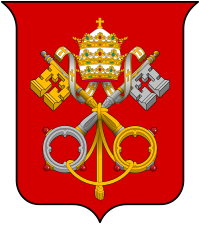This is an old revision of this page, as edited by Embattled Grady (talk | contribs) at 19:59, 14 August 2012 (Please provide a reference). The present address (URL) is a permanent link to this revision, which may differ significantly from the current revision.
Revision as of 19:59, 14 August 2012 by Embattled Grady (talk | contribs) (Please provide a reference)(diff) ← Previous revision | Latest revision (diff) | Newer revision → (diff)
|
| ||||||||||||||
The coats of arms of the Holy See and of the State of Vatican City. have represented the See of Rome since the fourteenth century, with some variance in the earliest centuries of its adoption, and the State of Vatican City since 1929.
History
Since the early thirteenth century, keys have been used as an emblem of the Holy See; by the early fourteenth century two keys crossed in saltire became the official insigne of the Holy See. Keys were used in the heraldic achievement of the See, the coats of arms of the Holy See and popes and on flags and banners of the Holy See, Papal States, popes and cardinals. The earliest thirteenth century flags display a single key with wards up and to the fly coloured argent (which is often displayed as white, though literally means "silver") on a red field. By the fourteenth century, flags display four keys upright with wards to the fly, each coloured argent, on a red flag with an argent cross between them; soon after, however, the keys began to appear in sets of two crossed in saltire, with four sets arranged with an argent cross between them. By the mid century fourteenth century, the crossed keys would sparatically displayed with a cord binding the keys together. At this time we also see the first example of two keys crossed in saltire displayed with the papal tiara on a red field, though both of the keys were still coloured argent at this time.
By the late fourteenth century, we have examples of flags displaying again the four sets of two keys crossed in saltire and tied about by a cord in the rings with the cross in, however, two sets were coloured argent while the other two Or (often shown in yellow, though literally meaning "gold"). Also found are two keys Or in saltire with a cord binding them on an argent field.
The gold key alludes to the power in the Kingdom of the Heavens, while silver one alludes to the spiritual authority of the papacy on earth. The wards are turned up towards Heaven and the grips turned down, and the cord that unites the grips alludes to the bond between the two powers. It is believed the keys were adopted as a symbol of the papacy because of a New Testament verse in which the Keys of the Kingdom of Heaven are promised to Saint Peter, with authority to bind and loose (Matthew 16:18–19). The tiara represents the three powers of the Supreme Pontiff; the three powers being Sacred Orders as Supreme Priest, Jurisdiction as Supreme Pastor and Magisterium as Supreme Teacher.
Coats of arms of the Catholic Church
No official coat of arms has been adopted by the Catholic Church, though attributed arms to the Church have been described over the centuries by heralds and artists. English manuscripts tend to favour a red field with two keys crossed in saltire. The Italian manuscripts use an argent field with a red cross, the arms of the cross embowed downward.
Coats of arms of the Papal States
The arms of the Papal States were the same as the arms of the reigning pope.
See also
External links
References
- ^ Holy See Press Office. "Coat of Arms of the Holy See and of the State of Vatican City". The Holy See. 15 March 2006. Web. 2 August 2012.
- ^ "Simboli e Figure Emblematiche ed Araldiche della Chiesa". Insegne e Simboli Araldica Pubblica e Privata, Medievale e Moderna. Rome: 1999. Ministero per i Beni e le Attivita Culturali Direzione Generale per gli Archivi. Web. 9 August 2012.
- Coat of Arms of His Holiness Benedict XVI
- Galbreath, Donald Lindsay. A Treatise on Ecclesiastical Heraldry. Cambridge: W. Heffer and Sons, 1930. Hathi Trust. Web. 10 August 2012.
| Coats of arms of Europe | |
|---|---|
| Sovereign states |
|
| States with limited recognition | |
| Dependencies and other entities | |
| Other entities | |
This heraldry-related article is a stub. You can help Misplaced Pages by expanding it. |

